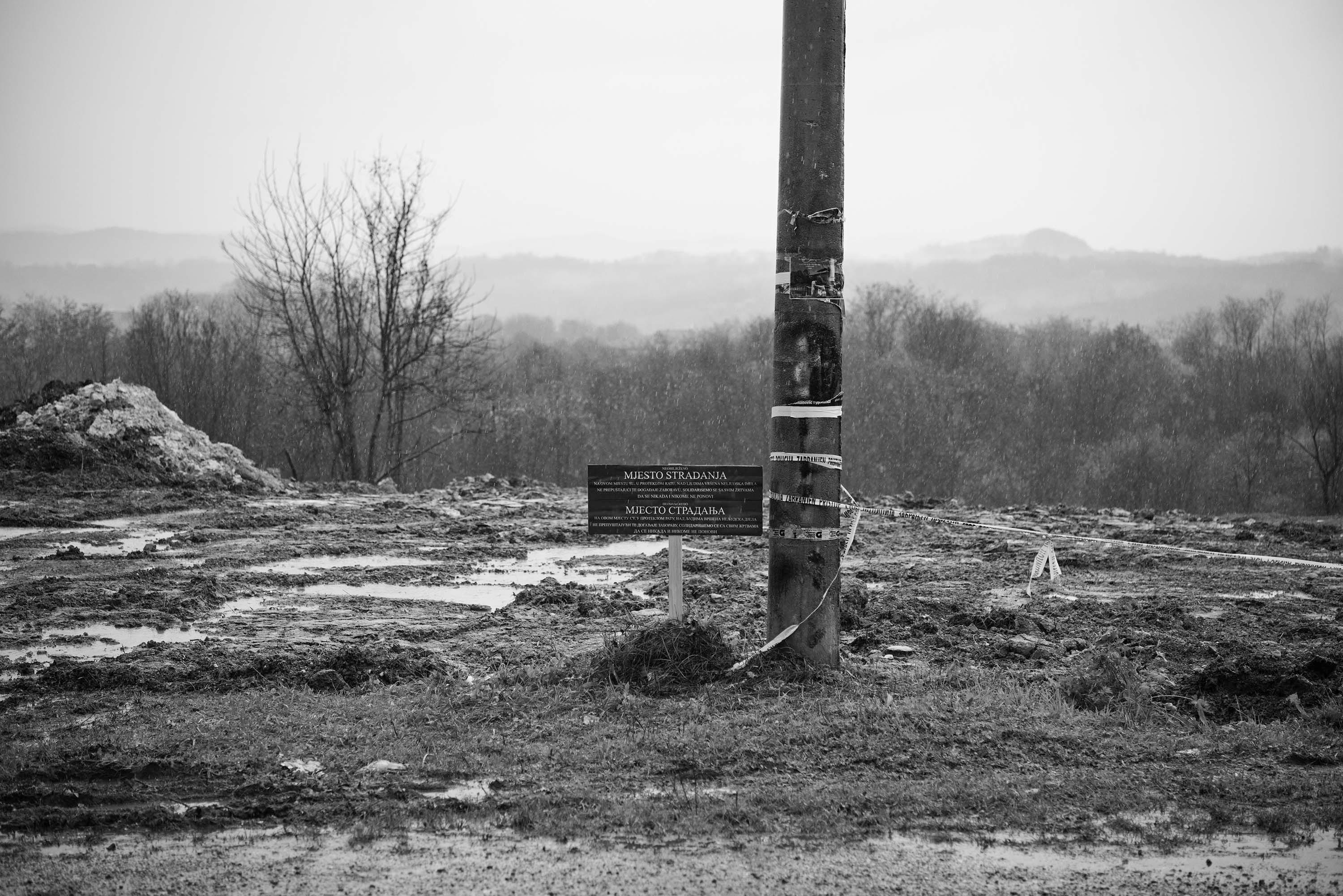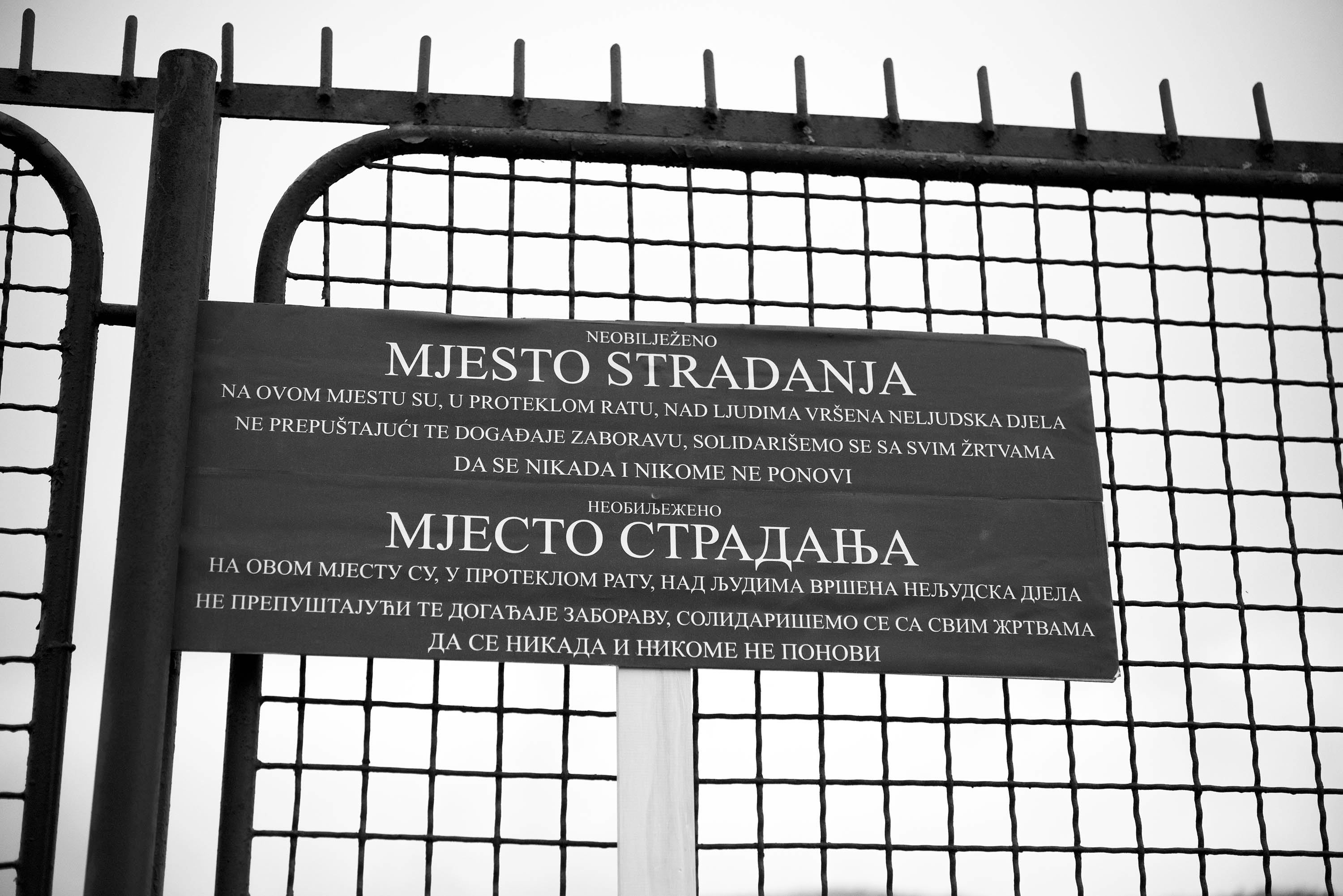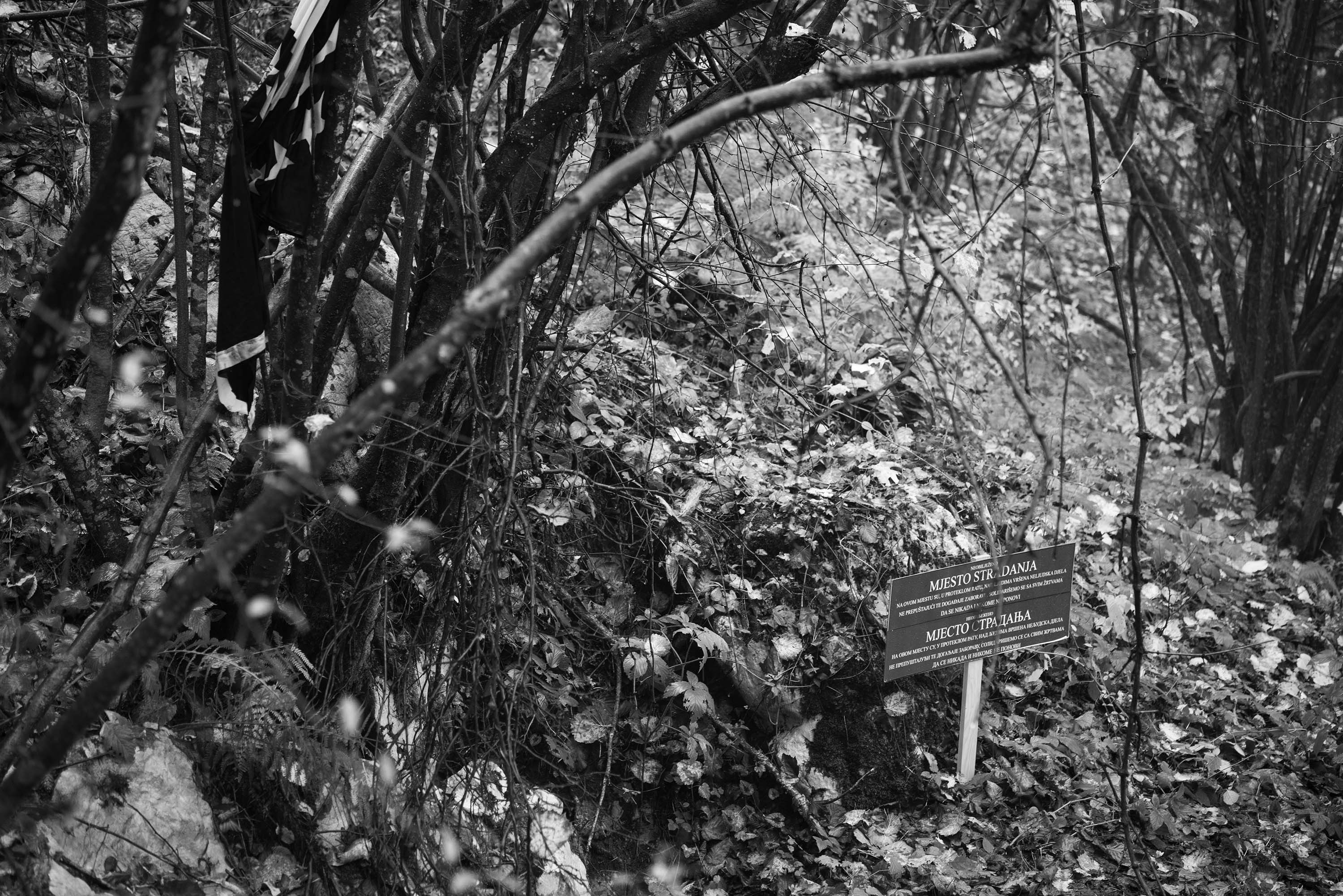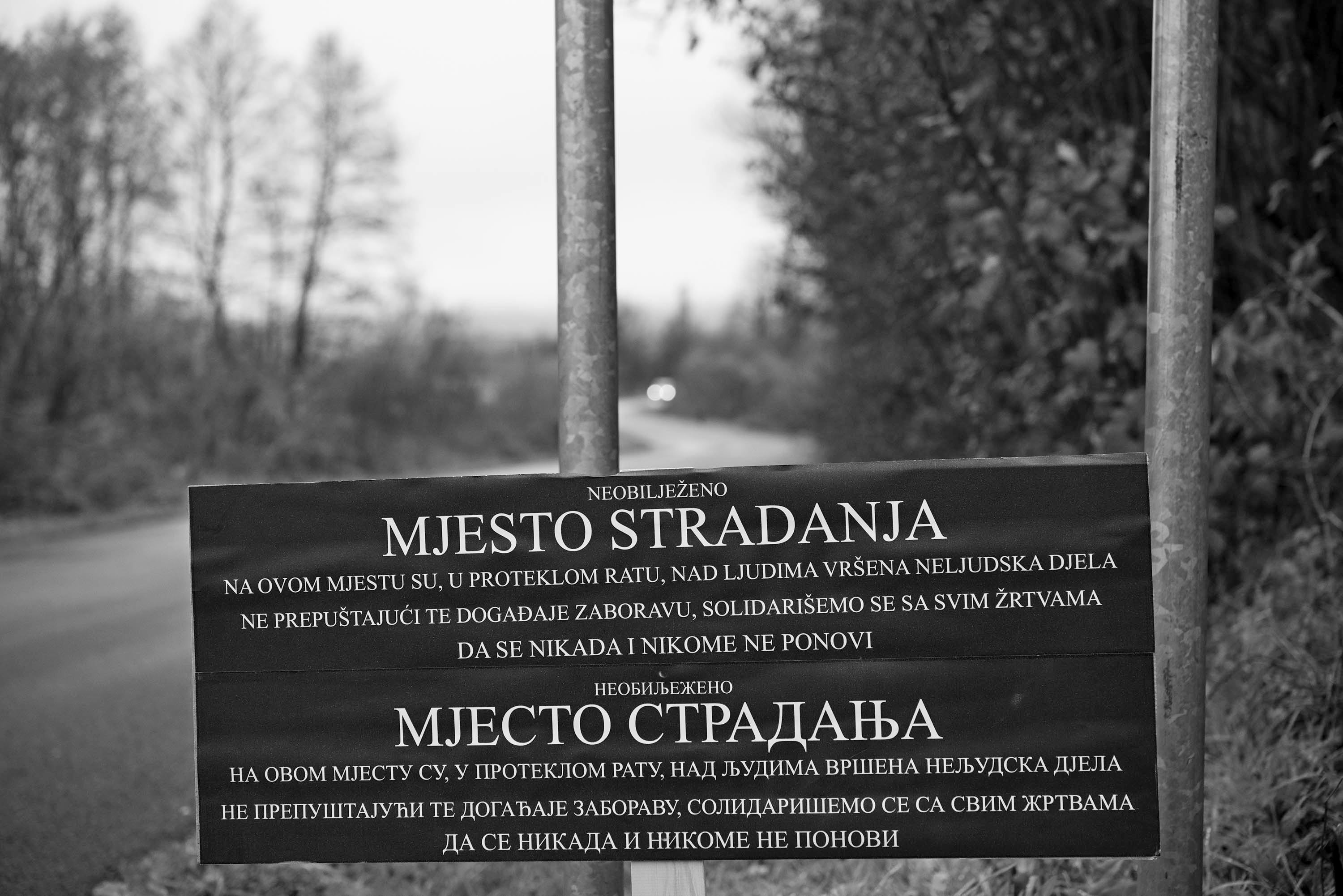A feeling of satisfaction mixed with sorrow. We are satisfied to have conducted our tenth action in the field, but sorrowful because we have visited Bosanska Krajina for the fourth time and walked the paths of wartime suffering whose end is not in sight, fearing that a hundred actions would not be enough to visit all the sites.
Bones
On the first day of the action, 12 November, we visited Sanski Most. We were welcomed by Slobodan Radošević from the Association of Returnees who connected us beforehand with family members of Serb victims killed in the nearby villages of Luška Palanka and Zdena. He said that returning to Sanski Most was a difficult step because the town and its surrounding area were the site of many crimes against Bosniaks in the period from the summer of 1992 to October 1995. Killings, concentration camps and deportations were common in the region until the arrival of units of the Army of RBiH. This is when a difficult period started for Serbs that had not escaped. In Luška Palanka, a village at the foot of Mount Grmeč, seven civilians were killed or presumed killed and another twelve in the Zdena suburb. These were mostly elderly people whose remains were exhumed in the years following the war. No one has been held responsible for these crimes, “but someone was responsible,” says Slobodan, showing a span between his index finger and thumb, “this is the responsibility of Serbs for suffering up until 10 October 1995, and this is the responsibility of Bosniaks after 10 October,” he says, narrowing the span to one or two centimetres, “but responsibility is responsibility and every victim deserves for someone to be held accountable.” In Zdena, Simo Mandić showed us the field where he found the remains of his mother, and in Luška Palanka, Boško Grbić took us to a house in front of which in 1999, he found the remains of his father, covered by a ripped-off car bonnet. He said he had recognised the bones, because his father was a large man and the double stitched trousers he often wore. “Every victim should be recorded, everyone who committed crimes should be prosecuted, this was not done by the Bosniak people, somebody killed him and that somebody has a name. People from Sarajevo helped me after the war with my claim in the company I worked work, at Unis, six of them, all Bosniaks. And the director who was a Serb held back, because I wouldn’t take up arms during war. I don’t want to hate and I cannot. It is a great shame what has happened to us, the cursed war,” Boško said with tears in his eyes, “and thank you for coming, this means a lot to us.” We set up signs at these sites and headed on to Prijedor.

On the second day of the action, 13 November, we started in Prijedor where we met with Edin Ramulić from the Culture of Memory Foundation. We went to the site of what was once the primary school and social centre in Rizvanovići near Prijedor. The buildings have been torn down and we found members of the Institute for Missing Persons overseeing the exhuming that is taking place there under the supervision of the Prosecutor’s Office of BiH. In July 1992, men from the surrounding villages were brought to this site and put on buses that took them to the concentration camps of Keraterm and Omarska. During the summer, Republika Srpska police and army forces established a check-point here. Civilians were brought to the site, detained and abused, and executions were carried out in the school yard and the orchard behind the school. Nine complete remains and one skull have been found to date. There are indications that the remains of up to twenty Bosniak civilians could be found in the area. Two excavators rhythmically removed layers of soil, observed by curious children dotting from the windows of the newly constructed school across the road. A combination of past and future that forces us to think about where we go from here, how do we raise children without hatred with the knowledge the someone killed their loved ones or members of their people, how do we free children belonging to the same group as those who committed crimes from a feeling of collective guilt. We placed out sign outside the area separated by yellow tape. Drenched with rain, we were shivering, both because of the cold and this new experience of being present during an exhumation.
Freedom
We continue on towards Novi Grad/Bosanski Novi. From early June to late August 1992, at least 700 Bosniak men from Bosanski Novi were detained at the Mlakve football stadium. Some of them had been moved from the concentration camps at Omarska, Trnopolje and Keraterm. The prisoners at the Mlakve football stadium were guarded by soldiers from the Republika Srpska Army and reserve forces of the JNA. They were beaten and humiliated, food and water was withheld and they did not receive medical aid. I remember when I spoke with a man who had been detained there and asked him how he fared. He told me, “It was hard, but when I sit with people from Prijedor and Sanski Most who were in the concentration camps, I feel ashamed to say anything.” When this site is mentioned in Novi Grad among the Serb war veterans, it is usually justified by being described as a transit centre and that if people had not been “sheltered” there, who knows how they would have ended up, because both domestic paramilitaries and those from what was Repuliblika Srpska Krajina at the time came to the area and were almost impossible to control. Today, just like a hundred and nine years ago, this stadium is home to the Sloboda [Freedom] Football Club. There is a lot of symbolism in that name.

The Pit
Our next destination was the Lisac pit. We start climbing Mount Grmeč. We know this mounted from school as it featured in the masterpieces of Branko Ćopić, a favourite Yugoslav writer. We walk through the centre of Krupa na Uni, a Serb majority municipality formed after the war. A sign points in the direction of the village of Hašani, Branko’s place of birth. We drive down that road through a landscape decorated in the colours of autumn, not even the rain can diminish its beauty. I look out for “old man Trišo’s mill” and “fledgling eagles”. We stop at the foot of a hill and Ajdin, who had already been to this site, tell us, “We’re here, now it’s uphill,” indicating the peak where a few trees stick out of the mist. We climb for half an hour or so, making our way through thick ferns and dense forest to find this natural pit. A stone mouth into a dark abyss. During exhumation in 2000, remains of fifty-one bodies were found there, including two females. The Bosniak prisoners taken from the Omarska concentration camp at the end of July 1992 were brought here by bus, executed and thrown into the pit. They had been pacified by lies that they were being taken to be exchanged. Unfortunately, in this war, there was no Nikoletina Bursać on Mount Grmeč to prevent this “kingdom of butterflies and bears” from becoming known for pits of evil containing dead bodies.

Optimism
On the last day of our action, 14 November, we returned to Sanski Most for a meeting with members of the Sanski Most Prison Camp Survivors Association. They welcomed us warmly and expressed support for our actions. The president of the Association, Sadmir Alibegović, pointed out that all victims should be respected and that he has understanding for all people who were made prisoner, saying, “If all the people who had been our guards were evil, you wouldn’t be sitting here today talking with any of us.” He said that the Association continues to promote the initiative for all pits in BiH that were used for hiding crimes to be closed with bricks and bars so that they can never be used for such purposes again. This has already been done with the Hrastova Glavica pit near Sanski Most and the Bezdana pit near Bihać.

This last action had added weight and significance because we were joined by families of the victims. We are encouraged by the gratitude that was expressed as it confirmed to us that we were doing the right thing. Having marked eighty-one sites of wartime suffering, we have shown that among the people, there is solidarity and empathy towards victims from all sides and that official memorialisation policies need to stifle each other by withholding the right to remember from people who have lost their loved ones in any area.
Our activities continue on social networks.
You can view the video from the action here:
Some of the media reports are available at the following links:
https://www.klix.ba/vijesti/bih/aktivisti-obiljezili-mjesta-stradanja-u-bosanskoj-krajini/191127083